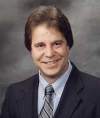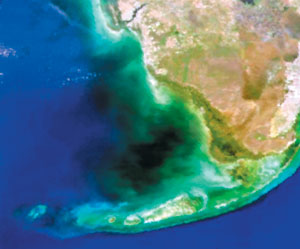What's new in exploration
Even earlier early life. A team of scientists at the University of Alabama at Birmingham (UAB), along with scientists at the University of California, Los Angeles (UCLA), have discovered signs of life that existed on Earth 3.5 billion years ago. Details of the discovery were published in the March 7 edition of Nature magazine. "This pushes back by a billion years the prior definitive evidence of the earliest life on earth," said UAB astrophysicist Thomas J. Wdowiak, a member of the UAB team that made the discovery. Wdowiak, et al., have been working on instrumentation to assess the existence of life on other worlds in the solar system, including Mars and Jupiter’s moon Europa. Wdowiak is one of 21 scientists on the Athena Team for the Mars exploration Rover vehicles to be landed on the red planet in 2004. UAB scientists knew that a good way to detect microbial fossils on earth and other planets was by using a novel laser-Raman imaging system, since it could be focused to a microscopic spot. Using the technique, the team found microscopic structures – fossil microbial cells – in 3.5 million-year-old rocks from Western Australia. The samples were from the collection of The Natural History Museum in London. The laser light that reflected off the samples allowed the scientists to map the organic fossil structures by their molecular vibrations; they appeared very much like cells seen under a regular microscope. "This means that things that have looked like fossils of ancient life are indeed ancient organic remains of microbes, much like the blue-green algae of pond scum," Wdowiak said. The laser-Raman imaging facility employed by the scientists was made possible through NASA-sponsored research at UAB on the growth of crystals in space. The current work on microbial fossils was supported by grants from the JPL/CalTech Astrobiology Center to Professor Schopf at UCLA, and from the NASA Exobiology Program to Professor Wdowiak at UAB. Slow earthquakes. New evidence indicates that an earthquake is going on right now on the West Coast of the U.S., yet no one feels it. Labeled a "slow earthquake," it has been ongoing since about Feb. 7, according to geologist Meghan Miller of Central Washington University. She was among the first scientists to use GPS technology to study earthquakes. An article written by Miller and colleagues, "Periodic slow earthquakes from the Cascadia subduction zone," was published in the March 29 edition of Science. The research was funded by the National Science Foundation (NSF). Miller says, "Until we had GPS, we regarded earthquake deformation in two main ways: long-term, steady-state faculty motions, and the elastic strain where faults are stuck and then suddenly let go during earthquakes. If it turns out that a major mechanism for releasing this elastic strain is through slow earthquakes that don’t generate seismic shaking, then they become very important to understand." Jim Whitcomb of NSF’s division of earth sciences, which funded the research, commented that, "Understanding these ‘silent earthquakes’ that we have been missing all these years will have a profound effect on our ability to predict hazards from volcanoes and earthquakes." These quakes occur in the transition-zone area of the plate-boundary fault, below where the tectonic plates are stuck and release strain during earthquakes, yet above the part where the fault slips continuously. "These areas seem to be ‘meta-stable’ – stuck enough that they don’t move until a critical threshold is reached and they slip, but don’t rupture catastrophically," explains Miller. "They can take place over the course of hours, days, weeks – maybe years." Miller and her colleagues have reviewed GPS data spanning a decade, determining that eight slow earthquakes took place in Puget Sound near Whidbey Island during that period, each about 14 months apart. However, Miller cautions, "Most times when we’ve recognized periodicity in solid-earth behavior, we’ve been wrong. And we can still be wrong here. But, certainly over the past 10 years it’s been highly periodic. Whether that holds for the entire inter-seismic cycle between great earthquakes is in question." Whether slow earthquakes can trigger – or forecast – larger, conventional temblors remains an unanswered question.
The Blob. Researchers are baffled by a giant, mysterious area of "black water" (a.k.a. "The Blob") offshore southwest Florida that seems to be a natural algae bloom – a common event – but this one is not the usual red tide variety. But even that’s an educated guess. Whatever it is, it is large. At its peak, the darkened water covered an estimated 700 sq mi (see photo). So far, no one sees any reason to panic. Although the algae may chase away fish, it doesn’t appear to kill them – nor does it appear dangerous to humans. There have been some reports of die-offs of sponges and other sea-bottom life in areas touched by the dark-water mass. Scientists are hinting, however, that they may never fully solve the mystery.
|
- Prices and governmental policies combine to stymie Canadian upstream growth (February 2024)
- U.S. producing gas wells increase despite low prices (February 2024)
- U.S. drilling: More of the same expected (February 2024)
- U.S. oil and natural gas production hits record highs (February 2024)
- Quantum computing and subsurface prediction (January 2024)
- U.S. upstream muddles along, with an eye toward 2024 (September 2023)




